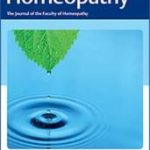Iris R Bell
The Complexity of the Homeopathic Healing Response Part 2: The Role of the Body as a Complex Adaptive System in Simillimum-Initiated Recovery from Disease
Homeopathy, 2020, 109 (2), 51-64

Background – Evidence indicates that homeopathic medicines are complex self-organizing nano-scale systems that generate unique low-intensity electromagnetic signals and/or quantum coherence domains. In Part 1, we reviewed relevant concepts from complex adaptive systems science on living systems for the nature of homeopathic healing. Aim – In Part 2, we discuss the complex-system nature of homeopathic medicines. The aim is to relate the evidence on the nature and properties of homeopathic medicines to the complex systems model for homeopathic healing. Methods and Results – The work is a narrative review, with complexity model development for the nature of homeopathic medicines. Studies suggest that homeopathic manufacturing generates nano-structures of source material, silica and silicon quantum dots if succussed in glassware or including botanical source materials; or carbon quantum dots if succussed in plastic or including any organic source materials, as well as solute-induced water nano-structures carrying medicine-specific information. On contact with physiological fluids (e.g., blood plasma), there is evidence that nano-structures additionally adsorb individualized patterns of the recipient’s own proteins on to their surfaces to create a unique protein corona coat (shell). Thus, the simillimum may generate a personalized biological identity upon administration. Consequently, a medicine can serve as an individually salient, self-similar information carrier, whose protein corona constituent pattern reflects the individual’s current internal state of health/disease. Homeopathic medicine complexity emerges from interactions of the component parts from source, silica from glassware or carbon from plastic containers, solvents (lactose, water, ethanol), adsorbed biomolecule layers from plant or animal sources, and adsorbed biomolecules of the recipient. Low doses of these complex medicines can act as biological signaling agents to initiate hormesis via a network-wide pattern of adaptive responses by the recipient complex adaptive system, rather than as conventional pharmaceutical drugs. Biological mediators of adaptive responses include inter-connected network elements of the cell danger/damage defense system: for example, gene expression, reactive oxygen species, heat shock proteins, cytokines, macrophages, T-cells, and associated brain–immune system mediator pathways. Conclusions – Every homeopathic medicine is a complex nano-scale system involving multiple inter-connected, interacting components, and emergent properties. Simillimum individualization derives from formation of a unique personalized protein corona shell adsorbed to the reactive surface of the homeopathic nano-structures on contact with the recipient’s body fluids. Low doses of such complex nano-structures initiate the adaptive processes of hormesis to mobilize endogenous healing of a disease state. The capacity for self-organization and self-similarity in complex systems is the key to future research on the nature of homeopathic medicines and systemic healing during individualized homeopathic treatment.






Lascia un commento
Devi essere connesso per inviare un commento.